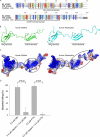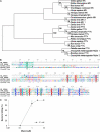Midkine and pleiotrophin have bactericidal properties: preserved antibacterial activity in a family of heparin-binding growth factors during evolution
- PMID: 20308059
- PMCID: PMC2871479
- DOI: 10.1074/jbc.M109.081232
Midkine and pleiotrophin have bactericidal properties: preserved antibacterial activity in a family of heparin-binding growth factors during evolution
Abstract
Antibacterial peptides of the innate immune system combat pathogenic microbes, but often have additional roles in promoting inflammation and as growth factors during tissue repair. Midkine (MK) and pleiotrophin (PTN) are the only two members of a family of heparin-binding growth factors. They show restricted expression during embryogenesis and are up-regulated in neoplasia. In addition, MK shows constitutive and inflammation-dependent expression in some non-transformed tissues of the adult. In the present study, we show that both MK and PTN display strong antibacterial activity, present at physiological salt concentrations. Electron microscopy of bacteria and experiments using artificial lipid bilayers suggest that MK and PTN exert their antibacterial action via a membrane disruption mechanism. The predicted structure of PTN, employing the previously solved MK structure as a template, indicates that both molecules consist of two domains, each containing three antiparallel beta-sheets. The antibacterial activity was mapped to the unordered C-terminal tails of both molecules and the last beta-sheets of the N-terminals. Analysis of the highly conserved MK and PTN orthologues from the amphibian Xenopus laevis and the fish Danio rerio suggests that they also harbor antibacterial activity in the corresponding domains. In support of an evolutionary conserved function it was found that the more distant orthologue, insect Miple2 from Drosophila melanogaster, also displays strong antibacterial activity. Taken together, the findings suggest that MK and PTN, in addition to their earlier described activities, may have previously unrealized important roles as innate antibiotics.
Figures






Similar articles
-
Identification and functional characterization of amphioxus Miple, ancestral type of vertebrate midkine/pleiotrophin homologues.Dev Comp Immunol. 2018 Dec;89:31-43. doi: 10.1016/j.dci.2018.08.005. Epub 2018 Aug 7. Dev Comp Immunol. 2018. PMID: 30096337
-
Miple1 and miple2 encode a family of MK/PTN homologues in Drosophila melanogaster.Dev Genes Evol. 2006 Jan;216(1):10-8. doi: 10.1007/s00427-005-0025-8. Epub 2005 Oct 12. Dev Genes Evol. 2006. PMID: 16220264
-
The midkine family in cancer, inflammation and neural development.Nagoya J Med Sci. 2005 Jun;67(3-4):71-82. Nagoya J Med Sci. 2005. PMID: 17375473 Review.
-
Midkine and pleiotrophin in neural development and cancer.Cancer Lett. 2004 Feb 20;204(2):127-43. doi: 10.1016/S0304-3835(03)00450-6. Cancer Lett. 2004. PMID: 15013213 Review.
-
The Drosophila midkine/pleiotrophin homologues Miple1 and Miple2 affect adult lifespan but are dispensable for alk signaling during embryonic gut formation.PLoS One. 2014 Nov 7;9(11):e112250. doi: 10.1371/journal.pone.0112250. eCollection 2014. PLoS One. 2014. PMID: 25380037 Free PMC article.
Cited by
-
Changes in the gene expression programs of renal mesangial cells during diabetic nephropathy.BMC Nephrol. 2012 Jul 28;13:70. doi: 10.1186/1471-2369-13-70. BMC Nephrol. 2012. PMID: 22839765 Free PMC article.
-
The Role of Midkine in Arteriogenesis, Involving Mechanosensing, Endothelial Cell Proliferation, and Vasodilation.Int J Mol Sci. 2018 Aug 29;19(9):2559. doi: 10.3390/ijms19092559. Int J Mol Sci. 2018. PMID: 30158425 Free PMC article. Review.
-
Midkine in host defence.Br J Pharmacol. 2014 Feb;171(4):859-69. doi: 10.1111/bph.12402. Br J Pharmacol. 2014. PMID: 24024937 Free PMC article. Review.
-
Midkine (MDK) in cancer and drug resistance: from inflammation to therapy.Discov Oncol. 2025 Jun 11;16(1):1062. doi: 10.1007/s12672-025-02941-1. Discov Oncol. 2025. PMID: 40500394 Free PMC article. Review.
-
Comparative transcriptome analyses of seven anurans reveal functions and adaptations of amphibian skin.Sci Rep. 2016 Apr 4;6:24069. doi: 10.1038/srep24069. Sci Rep. 2016. PMID: 27040083 Free PMC article.
References
Publication types
MeSH terms
Substances
LinkOut - more resources
Full Text Sources
Other Literature Sources
Medical
Molecular Biology Databases

